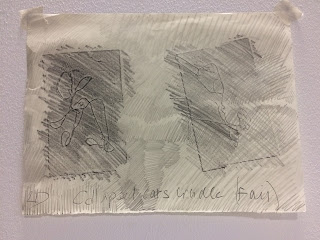I'm using the working title Pedestrian for current research. The kernal of this (a project titled Pastoral) is being revisited through the lens of being (a) pedestrian ALL of my life and through questioning the pedestrian, reserved, methodology I realise I've created. The starting point was the proposal:
A study of lines investigated under the terms of drawing in order to challenge the layers of linear systems in the real and metaphorical world.
pedestrian |pɪˈdɛstrɪən| nouna person walking rather than travelling in a vehicle: the road is so dangerous pedestrians avoid it | [as modifier] : a pedestrian bridge.adjectivelacking inspiration or excitement; dull: disenchantment with their pedestrian lives.
Been doing some plotting.... of my shopping trips and other routines and desire lines and pedestrian routes.
And have enjoyed lots of FOLDING......
planes; flat ones and paper ones.....how to make 4d drawings? How to understand Foucalt.
The fold as a '4d thing'. The constancy of all time and possiblilities at once.
Somehow this has to relate to the non plan, non map, non sense challenge of linear systems I've been railing against after realising I am in fact adapting constantly to a linear process (in my practice, research, my wider life).
And pricking.....
(because I think it was Klee who said a line is the distance between two points)
(and so where's the line if we just have points?)
(and don't quote me because it could just have easily been Kandinsky or even Whitehead and I'm writing in a space miles away from my copious notes and can't remember exactly..)
So it seems fairly disjointed, tenuously linked and chaotic right now and this is the tip of the iceberg: a tiny selection from pages and pages of notes and ideas. The temptation to focus it all using a...
linear |ˈlɪnɪə| adjective1 arranged in or extending along a straight or nearly straight line: linear movement.• consisting of or predominantly formed using lines or outlines: simple linear designs.• involving one dimension only: linear elasticity.• Mathematics able to be represented by a straight line on a graph:linear functions.• Mathematics involving or exhibiting directly proportional change in two related quantities: linear relationship.
2 progressing from one stage to another in a single series of steps; sequential: a linear narrative.
...approach is strong. Fear of losing the ideas, of revealing the whole experience when researching through practice (where practice for me IS me), OF GETTING LOST makes it all feel very vulnerable.
My notes on:
Murdo MacDonald: Drawing - Notes on an everyday art (2012)
I read this again and again and found that the questions I had were redundant!!!It answered a lot of what I had been pondering.
Everyday art - The working title for my proposal (concerned with challenging linear systems) is ‘Pedestrian’. I have recently discovered the word Quotidian. It is a complicated sounding word that means ‘everyday’. Drawing is not so everyday or pedestrian: a simple drawn line seems pedestrian but is extraordinarily complicated.
As Murdo says it can be the link between us and our realities, an existential bridge, it can be duplicitous,
contrary….contentious and subversive, it can be many things.
Is drawing concrete or even gestural? I have always assumed that, yes it’s gestural but not always concrete but now I’m confused. It’s not as simple (pedestrian) as assuming that paperless drawing*, something that I like to explore, for instance, isn’t concrete.
See Bram Arnold - Tuan YF Space and Place: the perspective of experience (Concrete Quote) ‘an object or place achieves concrete reality when our experience of it is total, that is, through all the senses, as well as with the active and reflective mind’
Im investigating linear systems through drawing to challenge my own working/thinking process because I’ve conditioned myself to work rationally, repetitively and without representation (of me or my subject) as a coping strategy against scatterbrain tendencies.
Murdo observes that ‘representation/resemblance’ comes into play whether you seek it or not or even actively dispense with it.
As to why this occurs is another dimension to my research. However abstract, I realised my drawing transmits some reference whether it’s optically in the drawing or contributed/projected by the viewer or is tapping into a universal knowledge….Murdo is more succinct - abstraction IS drawing.
The inversion of plane line and point illustrates how I adapted my research method/process and am now turning it around again.
From an indexical plotting - leading from point to point to create a line of thought/notion, a rational transect I designed to be able to control the results - to now trying to journey in a meandering gyroscopic sense, a bit like a Mobius strip continuously revisiting, with no beginning or end or plane or corner, something that looks like a straight line but in fact has nothing linear to it. Like an everyday labyrinth.
The text itself is an example of non-linear-ness. Each paragraph can be read in any order. In form it reads like a list. I am using lists in Pedestrian. Lists are organised in appearance but this one is gyroscopic I think. And each point is stand alone. Able to revisit any one in any permutation.
















